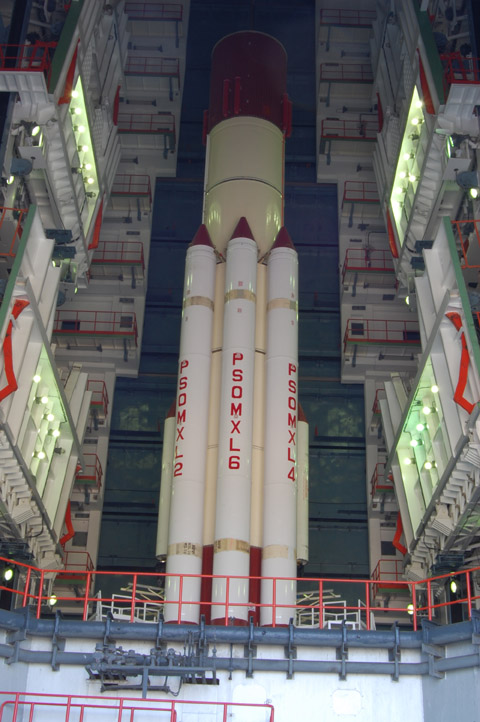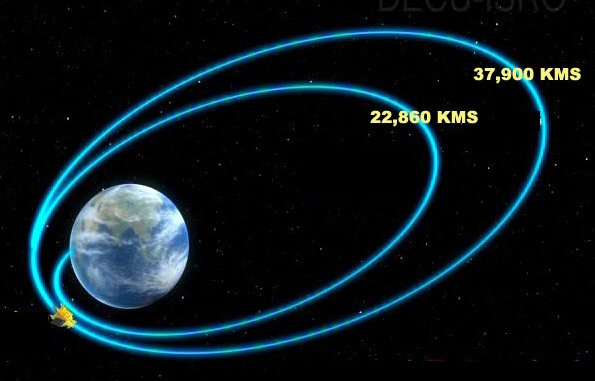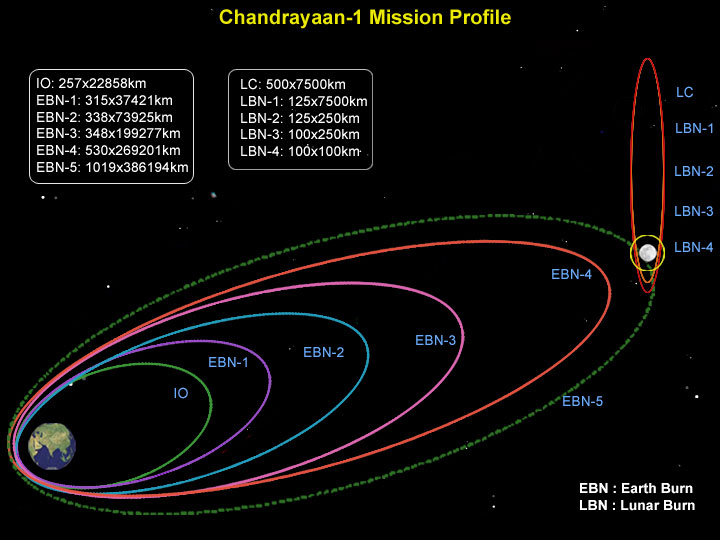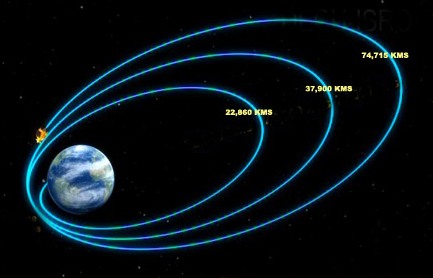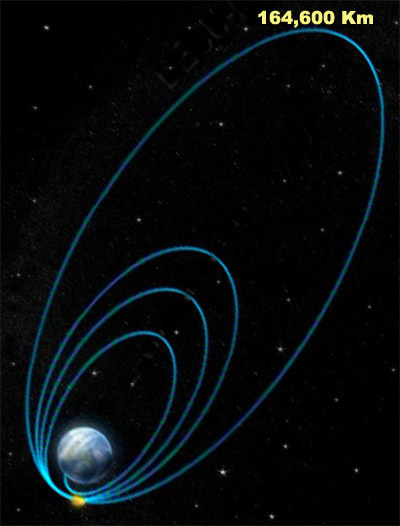Lunar Missions
India
|
India's Chandrayaan Blasts
Off To The Moon!
..
Mike Singh's Collection
(Edited by Pegasus)
AboveTopSecret.com
Discussion Thread Here
|
Originally posted by mikesingh,
a member of ATS,
posted on 21-10-2008 @ 06:13
PM Post
ID 5180184
India's
Chandrayaan Blasts Off To The Moon!
Sriharikota - India’s first unmanned flight to the
moon blasted off from Sriharikota, off the Andhra Pradesh coast, early
morning on Wednesday.
A 44-metre-tall and 316-tonne rocket called the Polar
Satellite Launch Vehicle (PSLV C11) carried the 1,380-kg lunar orbiter
Chandrayaan 1 from the Satish Dhawan Space Centre in Sriharikota at around
0620 hrs IST. |
| Posted by mikesingh, on October
21, 2008 Post
ID 5180185
On way to the Moon finally! So far it's been a text
book launch. Hopefully Chandrayaan will slip into Moon orbit as planned
in the next two weeks.
The Satellite
Chandrayaan-1, a 1.5 m cube weighing 1380 kg, is India’s
first unmanned mission to the Moon. It will spend two years performing
various experiments including high resolution mapping of the lunar surface
in visible light, near infrared, low energy and high energy X-rays.
In addition, the spacecraft will also evaluate the
Moon’s mineral resources and the distribution of elements such as silicon,
iron and titanium.
Chandrayaan-1 has a scientific package containing 12
instruments - two NASA, three European and seven Indian. This includes
a 30 kg Moon Impact Probe (MIP) which will be released from orbit to penetrate
the lunar surface.
NASA is providing the Moon Mineralogy Mapper (M3) and
the Miniature Synthetic Aperture Radar (MiniSAR), which will be able to
detect water ice up to a depth of several metres.
..
Moon Impact Probe integration with Chandrayaan-1
spacecraft. Courtesy: ISRO
..
Fully Assembled First Stage surrounded by strap-ons
of the PSLV-C11
..
PSLV-C11 on its way to the launch pad
..
Another view of the PSLV-C11on its way to the
launch pad from the Vehicle Assembly Building
Here’s an excellent brief of India’s Moon Program.
Target: 2020 for the first Indian on the Moon!
YouTube
Link
..
Indian Space
Research Organization
News
Updates from INBLive News
|
| Related Links:
|
India's Moon shot takes
to the skies
...
Successful launch of Chandrayaan-1
By Lester Haines
Posted in
Space, 22nd October 2008 08:44 GMT
India's Moon probe Chandrayaan-1
this morning successfully launched from Satish Dhawan Space Centre, the
Indian Space Research Organisation reports.
The $83m mission, carrying a multinational array of
kit, was carried aloft atop a Polar
Satellite Launch Vehicle at 06:22 Indian Standard Time (00:52 GMT).
Chandrayaan-1's principal science objective is to "conduct
mineralogical and chemical mapping of the lunar surface", for which it's
carrying eleven science payloads - six homegrown and five contributed by
international partners. India's instruments include the Terrain
Mapping Camera (TMC), designed to "map topography in both near and
far side of the Moon and prepare a three-dimensional atlas with high spatial
and altitude resolution"; the
Lunar
Laser Ranging Instrument (LLRI) ("to provide ranging data for determining
accurate altitude of the spacecraft above the lunar surface"); and the
High
Energy X-ray Spectrometer (HEX), which is described as "the first experiment
to carry out spectral studies of planetary surface at hard X-ray energies
using good energy resolution detectors".
NASA's contribution encompasses the Miniature
Synthetic Aperture Radar (Mini-SAR) - designed to "detect water ice
in the permanently shadowed regions on the lunar poles" - and the Moon
Mineralogy Mapper (M3), tasked with mapping "lunar surface mineralogy
in the context of lunar geologic evolution".
The European Space Agency, meanwhile, is on board with
three instruments, including the Sub
keV Atom Reflecting Analyser (SARA), which will apparently "image the
Moon's surface using low energy neutral atoms as diagnostics".
When it finally arrives at the Moon, Chandrayaan-1
will settle into orbit at an altitude of 100 km for its two-year mission.
Among the first tasks on the agenda is the deployment of the 29kg Moon
Impact Probe (MIP) which "will be ejected from Chandrayaan-1 spacecraft
at the earliest opportunity to hit the lunar surface in a chosen area".
|
| Posted by mikesingh, on October
21, 2008 Post
ID 5180922
The spacecraft has reached the highly elliptical Initial
Orbit (IO), with the perigee 250 km and apogee about 23,000 km and also
has deployed its solar panels successfully.
All systems are go!
Cheers!  |
| Posted by mikesingh, on October
22, 2008 Post
ID 5182247
Here's some more gen...
The Payloads
There are 11 payloads (scientific instruments) through
which Chandrayaan-1 intends to achieve its scientific objectives.
They include five instruments designed and developed
in India, three instruments from European Space Agency (one of which is
developed jointly with India and the other with Indian contribution), one
from Bulgaria and two from the United States.
The Indian payloads of Chandrayaan-1
Terrain Mapping Camera (TMC),
a CCD camera that maps the topography of the moon, which helps in better
understanding of the lunar evolution process.
Hyperspectral Imager (HySI),
another CCD camera, is designed for mapping of the minerals on the lunar
surface as well as for understanding the mineralogical composition of Moon’s
interior.
Lunar Laser Ranging Instrument
(LLRI) provides necessary data for accurately determining the height
of lunar surface features.
High Energy X-ray Spectrometer
(HEX) is designed to help explore the possibility of identifying
Polar Regions covered by thick water-ice deposits as well as in identifying
regions of high Uranium and Thorium concentrations.
Moon Impact Probe (MIP)
demonstrates the technologies required for landing a probe at the desired
location on the moon. It is also intended to qualify some of the technologies
related to future soft landing missions.
The six international payloads
of Chandrayaan-1
Imaging X ray Spectrometer (C1XS),
an ESA payload and jointly developed by Rutherford Appleton Laboratory
of England and ISRO Satellite Centre, Bangalore, intends is to carry out
high quality mapping of the moon using X-ray fluorescence technique for
finding the presnce of Magnesium, Aluminium, Silicon, Iron and Titanium
distributed over the surface of the Moon.
Smart Near Infrared Spectrometer
(SIR-2), another ESA payload, developed by Max Plank Institute of
Germany, aims to study the lunar surface to explore the mineral resources
and the formation of its surface features.
Sub kiloelectronvolt Atom Reflecting
Analyser (SAR), the third payload from ESA, is built by Swedish
Institute of Space Physics and Space Physics Laboratory of Vikram Sarabhai
Space Centre, Tiruvananthapuram. The aim of this instrument is to study
the surface composition of the moon and the magnetic anomalies associated
with the surface of the moon.
Radiation Dose Monitor (RADOM),
a payload developed by Bulgarian Academy of Sciences, aims to characterise
the radiation environment in a region of space surrounding the moon.
Mini Synthetic Aperture Radar
(MiniSAR) is one of the two scientific instruments from the USA
and is from Johns Hopkins University’s Applied Physics Laboratory and
Naval Air Warfare Centre, USA through NASA. MiniSAR is mainly intended
for detecting water ice in the permanently shadowed regions of the lunar
poles up to a depth of a few meters.
Moon Mineralogy Mapper (M3)
is an imaging spectrometer from Brown University and Jet Propulsion Laboratory
of the US through NASA, is intended to assess and map lunar mineral resources
at high spatial and spectral resolution.
SOURCE: ISRO
Payload
Quite a payload, what?
Cheers!  |
| Posted by mikesingh, on October
23, 2008 Post
ID 5189296
Update: 23 Oct 08
The first orbit-raising manoeuvre of Chandrayaan-1
spacecraft was performed at 09:00 hrs Indian Standard Time (IST) this morning
(October 23, 2008) when the spacecraft’s 440 Newton Liquid Engine was
fired for about 18 minutes by commanding the spacecraft from Spacecraft
Control Centre (SCC) at ISRO Telemetry, Tracking and Command Network (ISTRAC)
at Peenya, Bangalore.
With this engine firing, Chandrayaan-1’s apogee has
been raised to 37,900 km, while its perigee has been raised a little, to
305 km. In this orbit, Chandrayaan-1 spacecraft takes about 11 hours to
go round the Earth once.
SOURCE: ISRO
Cheers!  |
Chandrayaan-1 Spacecraft’s
Orbit Raised
...
Courtesy: ISRO
October 23, 2008
The first orbit-raising manoeuvre of Chandrayaan-1
spacecraft was performed at 09:00 hrs Indian Standard Time (IST) this morning
(October 23, 2008) when the spacecraft’s 440 Newton Liquid Engine was
fired for about 18 minutes by commanding the spacecraft from Spacecraft
Control Centre (SCC) at ISRO Telemetry, Tracking and Command Network (ISTRAC)
at Peenya, Bangalore.? With this engine firing, Chandrayaan-1’s apogee
has been raised to 37,900 km, while its perigee has been raised a little,
to 305 km. In this orbit, Chandrayaan-1 spacecraft takes about 11 hours
to go round the Earth once.
Chandrayaan-1, India’s first spacecraft to Moon,
was successfully launched by PSLV-C11 yesterday (October 22, 2008) from
Satish Dhawan Space Centre SHAR, Sriharikota. The launch vehicle placed
Chandrayaan-1 in an elliptical orbit with a perigee (closest point to the
earth) of 255 km and apogee (farthest point to earth) of 22,860 km. In
this initial orbit, Chandrayaan-1 orbited the Earth once in about six and
a half hours. Following its successful launch, the SCC acquired the first
signals and conducted preliminary operations on Chandrayaan-1. The Deep
Space Network (DSN) at Bylalu tracked the spacecraft in this orbit and
received signals in S and X band and has sent commands to the spacecraft.
All systems onboard the spacecraft are functioning
normally. Further orbit raising maneuvers are planned in the coming few
days.
http://www.isro.gov.in/pressrelease/Oct23_2008.htm |
| Posted by mikesingh, on October
24, 2008 Post
ID 5193101
Originally posted by bubbapug1985
Whats the big deal? The US
did all of this over 40 years ago, they are still way behind.
So what has NASA to show for it except for screwed
up pics with resolutions that suck!! (At least the ones they've shown to
the public!) and a few kilos of Moon rock?
What will they learn differently
from going to the moon that the US didnt?
Why waste time with the moon.
The US/NASA/Naval int still don't know everything about
the Moon yet. Heck, we've been on Earth for 20000 years and still know
zilch about it! We know probably just about 1% of what the Moon is all
about. :P
Now let's see what India's Chandrayaan is going to
do that have NOT been done by any country so far:
3D terrain mapping that will map the ENTIRE topography
of the moon, which helps in better understanding of the lunar evolution
process.
Mapping of the minerals on the lunar surface as well
as for understanding the mineralogical composition of the Moon’s interior
by the Hyperspectral Imager (HySI).
Obtaining data for accurately determining the height
of lunar surface features with the help of the Lunar Laser Ranging Instrument
(LLRI).
Exploring the possibility of identifying Polar Regions
covered by thick water-ice deposits as well as in identifying regions of
high Uranium and Thorium concentrations with the High Energy X-ray Spectrometer
(HEX).
High quality mapping of the moon using X-ray fluorescence
technique for finding the presence of Magnesium, Aluminum, Silicon, Iron
and Titanium distributed over the surface of the Moon with the Imaging
X ray Spectrometer (C1XS).
Study of the lunar surface to explore the mineral resources
and the formation of its surface features with the Smart Near Infrared
Spectrometer (SIR-2).
Study the surface composition of the moon and the magnetic
anomalies associated with the surface of the moon using the Sub kiloelectronvolt
Atom Reflecting Analyser (SAR).
Characterization of the radiation environment in a
region of space surrounding the moon by the Radiation Dose Monitor (RADOM).
Mini Synthetic Aperture Radar (MiniSAR) for detecting
water ice in the permanently shadowed regions of the lunar poles up to
a depth of a few meters.
To assess and map lunar mineral resources at high spatial
and spectral resolution with the help of an imaging spectrometer called
the Moon Mineralogy Mapper (M3).
And don’t forget the presence of Helium 3 / 4 that
the Moon Impact Probe will evaluate, which is an important facet of the
mission.
So, do you now see what no other nation, including
the U.S, has done in any detail so far? Chandrayaan will!
Cheers!  |
| Posted by mikesingh, on October
24, 2008 Post
ID 5194059
Originally posted by sentinel2107
MikeS!! When is the next
orbital "enlargement" of Chandrayaan due? Any ideas?
Yep! As I had mentioned earlier, on 23rd Oct the first
orbit-raising manoeuvre of Chandrayaan-1 spacecraft was performed at 09:00
hrs Indian Standard Time (IST) when the spacecraft’s 440 Newton Liquid
Engine was fired for about 18 minutes by commanding the spacecraft from
Spacecraft Control Centre (SCC) at ISRO Telemetry, Tracking and Command
Network (ISTRAC) at Peenya, Bangalore.
With this, Chandrayaan-1’s apogee was raised to 37,900
km, while its perigee has been raised to 305 km.
The next firing is being done today, 24th Oct when
the LAM (Lunar Apogee Motor) would be fired to take the spacecraft to an
apogee of 73,000 km and a perigee of 300 km. Pretty elliptical, what? :o
The two huge antennas at the Indian Deep Space Network
near Bangalore have commenced receiving signals from it.
Cheers!  |
| Posted by mikesingh, on October
25, 2008 Post
ID 5194059
UPDATE: 25th OCT 05:48h
The second orbit-raising manoeuvre has been carried
out at 05:48 hrs IST, 25th Oct. The spacecraft’s Newton Liquid Engine
was fired for about 16 minutes from the Telemetry Tracking and Command
Network (ISTRAC) at Bangalore. The apogee has now been further raised to
74,715 km, while its perigee has been raised to 336 km.
The Indian Deep Space Network is tracking the spacecraft,
and receiving signals in S and X bands.
All systems on board the spacecraft are functioning
normally. Further orbit raising maneuvers to take Chandrayaan-1 to still
higher orbits are planned in the next few days.
Mission Profile
...
Courtesy: ISRO
Cheers! 
Chandrayaan-1 Spacecraft’s
Orbit Raised Further
...
Courtesy: ISRO
October 25, 2008
The second orbit-raising manoeuvre of Chandrayaan-1
spacecraft was carried out at 05:48 hrs IST this morning (October 25, 2008)
when the spacecraft’s 440 Newton Liquid Engine was fired for about 16
minutes by commanding the spacecraft from Spacecraft Control Centre (SCC)
at ISRO Telemetry, Tracking and Command Network (ISTRAC) at Peenya, Bangalore.?
With this engine firing, Chandrayaan-1’s apogee has been further raised
to 74,715 km, while its perigee has been raised to 336 km. In this orbit,
Chandrayaan-1 spacecraft takes about twenty-five and a half hours to go
round the Earth once. This is the first time an Indian spacecraft has gone
beyond the 36,000 km high geostationary orbit and reached an altitude more
than twice that height.
It may be recalled that Chandrayaan-1, India’s first
spacecraft to Moon, was successfully launched by PSLV-C11 on October 22,
2008 from Satish Dhawan Space Centre SHAR, Sriharikota. The launch vehicle
placed Chandrayaan-1 in an elliptical orbit with a perigee (closest point
to earth) of 255 km and apogee (farthest point to earth) of 22,860 km.
The first orbit-raising manoeuvre was performed on October 23, 2008 by
firing the spacecraft’s liquid engine for 18 minutes resulting in the
increase of the spacecraft orbit’s apogee to 37,900 km and the perigee
to 305 km. The Indian Deep Space Network (IDSN) at Bylalu is tracking the
spacecraft in the present orbit, receiving signals in S and X bands and
is sending commands to the spacecraft.
All systems onboard the spacecraft are functioning
normally. Further orbit raising maneuvers to take Chandrayaan-1 to still
higher orbits are planned in the next few days.
http://www.isro.gov.in/pressrelease/Oct25_2008a.htm
|
Chandrayaan-1 enters Deep
Space
...
Courtesy: ISRO
October 26, 2008
Chandrayaan-1 spacecraft has entered deep space after
crossing the 150,000 km (one and a half lakh km) distance mark from the
Earth. ?This happened after the successful completion of the spacecraft’s
third orbit raising manoeuvre today (October 26, 2008) morning.
During this manoeuvre which was initiated at 07:08
IST, the spacecraft’s 440 Newton liquid engine was fired for about nine
and a half minutes. With this, Chandrayaan-1 entered a much higher elliptical
orbit around the Earth. The apogee (farthest point to Earth) of this orbit
lies at 164,600 km while the perigee (nearest point to Earth) is at 348
km. In this orbit, Chandrayaan-1 takes about 73 hours to go round the Earth
once.
The antennas of the Indian Deep Space Network at Byalalu
are playing a crucial role in tracking and communicating with Chandrayaan-1
spacecraft in such a high orbit. The spacecraft performance is normal.
More orbit raising manoeuvres are planned in the coming few days to take
Chandrayaan-1 towards the Moon.
http://www.isro.gov.in/pressrelease/Oct26_2008.htm |
Chandrayaan-1: The Journey
...
Courtesy: ISRO
October, 2008
The launch of Chandrayaan-1 takes place from the Second
Launch Pad at Satish Dhawan Space Centre, SHAR, Sriharikota in the Nellore
district of Andhra Pradesh state. Sriharikota is situated at a distance
of about 80 km to the North of Chennai.
Chandrayaan-1 spacecraft begins its journey from earth
onboard India's Polar Satellite Launch Vehicle (PSLV-C11) and first will
reach a highly elliptical Initial Orbit (IO). In the Initial Orbit, the
perigee (nearest point to earth) is about 250 km and apogee (farthest point
from the earth) is about 23,000 km.
After circling the Earth in its Initial Orbit for a
while, Chandrayaan-1 spacecraft is taken into two more elliptical orbits
whose apogees lie still higher at 37,000 km and 73,000 km respectively.
This is done at opportune moments by firing the spacecraft's Liquid Apogee
Motor (LAM) when the spacecraft is near perigee.
Subsequently, LAM is fired again to take Chandrayaan-1
spacecraft to an extremely high elliptical orbit whose apogee lies at about
387,000 km.
In this orbit, the spacecraft makes one complete revolution
around the Earth in about 11 days. During its second revolution around
the Earth in this orbit, the spacecraft will approach the Moon's North
pole at a safe distance of about a few hundred kilometers since the Moon
would have arrived there in its journey round the Earth.
Once the Chandrayaan-1 reaches the vicinity of the
Moon, the spacecraft is oriented in a particular way and its LAM is again
fired. This slows down the spacecraft sufficiently to enable the gravity
of the moon to capture it into an elliptical orbit.
Following this, the height of the spacecraft's orbit
around the moon is reduced in steps. After a careful and detailed observation
of perturbations in its intermediate orbits around the moon, the height
of Chandrayaan-1 spacecraft's orbit will be finally lowered to its intended
100 km height from the lunar surface.
Later, the Moon Impact Probe will be ejected from Chandrayaan-1
spacecraft at the earliest opportunity to hit the lunar surface in a chosen
area. Following this, cameras and other scientific instruments are turned
ON and thoroughly tested. This leads to the operational phase of the mission.
This phase lasts about two years during which Chandrayaan-1 spacecraft
explores the lunar surface with its array of instruments that includes
cameras, spectrometers and SAR.
http://www.isro.gov.in/pslv%2Dc11/brochure/page9.htm
...
Courtesy: ISRO
|
|
Continue
Here at AboveTopSecret.com
|
| FAIR USE NOTICE: This page contains copyrighted
material the use of which has not been specifically authorized by the copyright
owner. Pegasus Research Consortium distributes this material without profit
to those who have expressed a prior interest in receiving the included
information for research and educational purposes. We believe this constitutes
a fair use of any such copyrighted material as provided for in 17 U.S.C
§ 107. If you wish to use copyrighted material from this site for purposes
of your own that go beyond fair use, you must obtain permission from the
copyright owner. |
|
~ MENU ~
|


